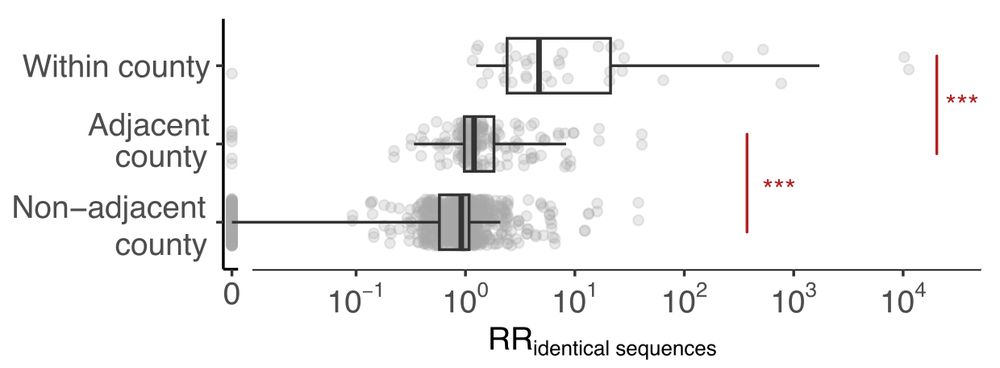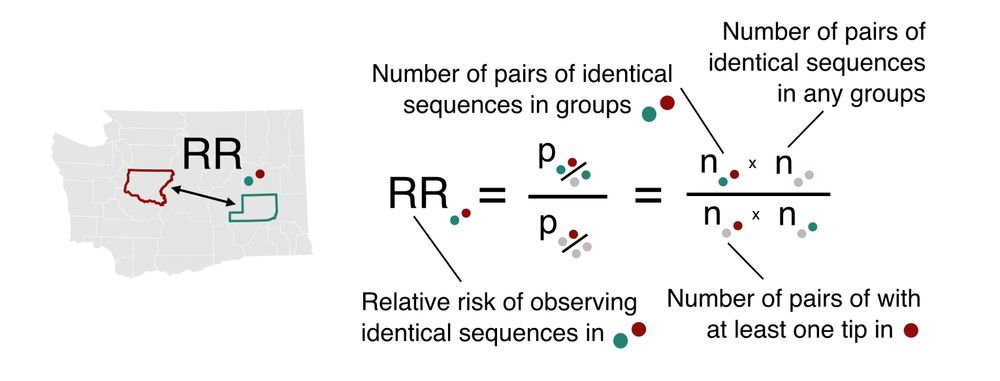
Cécile Tran Kiem
@ceciletk.bsky.social
Postdoc at Fred Hutchinson Cancer Center on mathematical modelling of infectious diseases, she/her.
This work could not have been possible without many people, including Trevor Bedford, Amanda Perofsky and @paredesmig.bsky.social, and all the hard work at @doh.wa.gov, @brotmanbaty.bsky.social and UW Virology to build a genomic sentinel SARS-CoV-2 surveillance with detailed linked metadata! 7/
March 5, 2025 at 4:48 PM
This work could not have been possible without many people, including Trevor Bedford, Amanda Perofsky and @paredesmig.bsky.social, and all the hard work at @doh.wa.gov, @brotmanbaty.bsky.social and UW Virology to build a genomic sentinel SARS-CoV-2 surveillance with detailed linked metadata! 7/
Finally, building on the expectation that infectors should tend to be observed first within pairs of identical sequences, we use the timing of sequence collection to understand the groups driving transmission. 6/
March 5, 2025 at 4:48 PM
Finally, building on the expectation that infectors should tend to be observed first within pairs of identical sequences, we use the timing of sequence collection to understand the groups driving transmission. 6/
Patterns of occurrence of identical sequences between age groups show assortativity in age mixing and transmission between generations. Jointly analyzing the ages & geographies of pairs of identical sequences, we find that age transmission patterns vary across spatial scales. 5/

March 5, 2025 at 4:48 PM
Patterns of occurrence of identical sequences between age groups show assortativity in age mixing and transmission between generations. Jointly analyzing the ages & geographies of pairs of identical sequences, we find that age transmission patterns vary across spatial scales. 5/
The location of pairs of identical sequences is in line with expectations from cell phone derived mobility data. Outliers in the relationship between genetic and mobility data can be explained by large clusters of identical sequences shared between male prisons' postal codes. 4/

March 5, 2025 at 4:48 PM
The location of pairs of identical sequences is in line with expectations from cell phone derived mobility data. Outliers in the relationship between genetic and mobility data can be explained by large clusters of identical sequences shared between male prisons' postal codes. 4/
Applying the framework to more than 114,000 SARS-CoV-2 sequences collected through genomic sentinel surveillance in WA, USA between Mar 2021 & Dec 2022, we find a strong signal for local spread, with identical sequences having an increased risk of being observed between nearby counties. 3/

March 5, 2025 at 4:48 PM
Applying the framework to more than 114,000 SARS-CoV-2 sequences collected through genomic sentinel surveillance in WA, USA between Mar 2021 & Dec 2022, we find a strong signal for local spread, with identical sequences having an increased risk of being observed between nearby counties. 3/
Genetic proximity between infecting viruses indicates epidemiological linkage. Here, we introduce a relative risk (RR) metric that quantifies how the number of pairs of identical sequences in two groups differs from what we expect from the sequencing effort. 2/

March 5, 2025 at 4:48 PM
Genetic proximity between infecting viruses indicates epidemiological linkage. Here, we introduce a relative risk (RR) metric that quantifies how the number of pairs of identical sequences in two groups differs from what we expect from the sequencing effort. 2/

